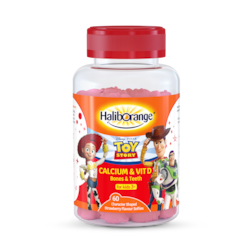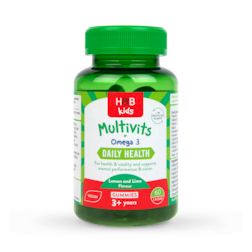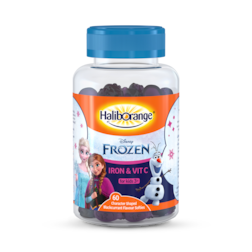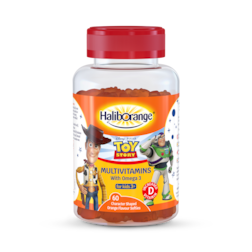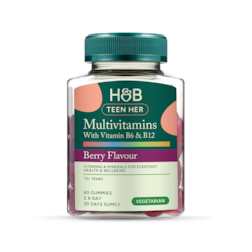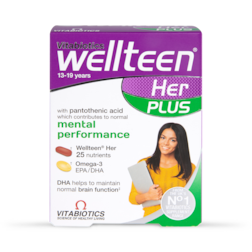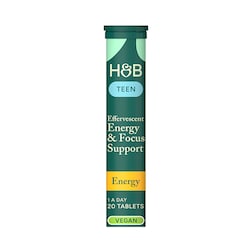15% off €25
Code:DEAL
Our best vitamins for kids and teenagers

Are your kids getting what they need? Parents, breathe a sigh of relief – we've got vitamins to suit active teens and Frozen fans alike
Our top picks
Daily vits with help from Elsa
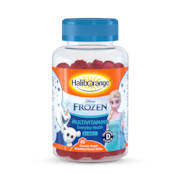
Haliborange
Haliborange Disney Frozen Multivitamin 60 Strawberry Flavour Softies
€14.99
Supports teens' bones and muscles
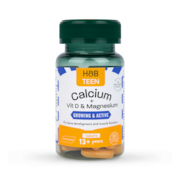
Holland & Barrett
Holland & Barrett Teens Growing & Active Calcium, Vitamin D & Magnesium 30 Tablets
3 for 2 Mix & Match
€5.84
€11.99
Everyday support for teen boys
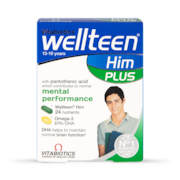
Vitabiotics
Vitabiotics Wellteen Him Plus 56 Tablets
Buy one get one 1/2 price
€24.99
Between growth spurts and busy lives, kids can sometimes benefit from a few extra nutrients. And older children may need extra help as they navigate new stages and routines through their teenage years.
Our top vitamins for kids
Vitamin time just got more exciting – Elsa and Olaf are here to join the fun, and your little one will get seven essential vitamins needed for their daily health and growth.
Vitamin A supports normal vision, while vitamin D helps young bones grow normally.1,2 Five vitamins (A, C, B6, B12 and D) support their immunity and a B complex (B3, 6 and 12) plus vitamin C helps reduce tiredness and fatigue.3-11
They’ll also get half of their daily vitamin E per softie, which helps protect cells in the body from oxidative stress.12
Give them one to two gummies per day on top of a balanced diet for support with the nutrients they need to learn, grow and play. Suitable for ages 3+.
Strong bones aren’t just important now – they're for life! So, keep kids running and jumping by giving them a balanced diet and add supplements if they need a little extra support.
You've got a friend in these strawberry softies as they provide calcium and vitamin D, which work together to support bone health. Kids need both for normal bone development, and vitamin D increases how much calcium their bodies can absorb.13,14 Not only that, but it helps look after muscles and teeth.15,16
The UK government suggests that all children aged six months to five years take a vitamin D supplement every day of the year – so consider these ones for the Buzz Lightyear fan in your life.17
The morning routine’s enough of a rush, so taking vitamins should be as fun and easy as possible. Give them five essential vitamins plus omega-3 in one gummy (even better: they’re lemon and lime flavoured).
Vitamin A helps keep their vision sharp while vitamin D supports strong bones, muscles and teeth.1,15,16,18 Vitamin C helps the immune system and vitamin E protects cells from everyday damage like oxidative stress.6,12,19
Last but not least there’s flaxseed oil, a source of essential fatty acids to support children’s growth and development.*20
Ideal for sweet lovers and veggie and vegan kids alike – just give kids aged 3+ one gummy per day on top of a balanced diet. Et voilà: you can feel more confident that they’ve got all the goodness they need.
*This beneficial effect is achieved with a daily intake of 2g of alpha linoleic acid (ALA) and 10g of linoleic acid (LA).
Concerned they’re not getting enough iron? Let it go... Their favourite Frozen characters are back, this time offering the essential nutrient plus vitamin C.
Iron plays an important role in cognitive development and growing properly.21,22 It might be a bit harder for your child to get iron if they have a limited diet.22 So these blackcurrant-flavoured softies are ideal for a little extra help.
Not only does vitamin C support the immune system and help reduce tiredness, but it increases iron absorption.6,11,23 Together, they’re a perfect pair to help them stay well and full of energy.
Kids aged 3+ can chew one to two of these softies per day. Which Frozen shape will they find?
Fun fact: omega-3 isn’t just one ingredient. It’s made up of fatty acids DHA, EPA and ALA.
The best sources of ALA are nuts and seeds, so your child might need help from supplements if they don’t eat these.20
In come these tasty orange softies, suitable for ages 3+ and with 200mg ALA per serving (two softies), which is needed for children’s normal growth and development.24 Just give them one to two per day for an extra source of omega-3s.
Our top vitamins for teens
Your teens might act like they’re all grown up – but when it comes to their bones, they’re far from it. This one-a-day multivitamin is formulated for growing bodies aged 13+, supporting teenage joints, bones and muscles.
Most of us know about calcium for bones – but it supports muscle health and teeth too.27,28,29 There’s 50% of a teen’s calcium NRV (the recommended amount for good health) in a daily tablet.
Got a teen that won’t stomach tablets? These berry-flavoured multivit gummies could be the answer.
They’re formulated for ages 13+ and made to support girls' and young women's daily needs. Two gummies (a daily dose) provides a source of iodine, needed for normal growth in children, cognitive function, thyroid hormone health and skin.33-36
There’s also vitamin C, vitamin D and a B vitamin complex, plus vitamin A for normal iron metabolism – crucial if they’re one of the 49% of teenage girls low in iron.37,38
Oh, and these are vegetarian – even better.
Juggling studies, sports and a busy social life all takes its toll. Developed for teenage girls aged 13-19, it provides 25 vitamins and minerals to support their everyday health.
These quick and easy tablets contain vitamins B6, B12 and vitamin C, which all help to reduce tiredness and fatigue.9,10,11
There’s also iron – something almost half of teenage girls are low in.38 Iron’s crucial for normal cognitive function, meaning they need it for concentration at school.39
Plus, there’s vitamin D (which supports immune function and healthy bones) as well as immune-supporting zinc, selenium, folic acid and vitamins B6 and B12.4,5,18,40-43
Just like Her Plus, Vitabiotics’ gummies for teenage boys are designed to support a busy and ever-changing life. Help them stay healthy for exams, exercise and whatever else this period throws at them.
These chewable multivits are designed for boys aged 13-19 and contain 24 vitamins and minerals to look after normal mental performance, brain function and energy release (to name just a few). Vitamins B6, B12 and vitamin C help reduce tiredness and fatigue, setting them up for hectic days.9,10,11
What’s more, vitamin D (which everyone’s recommended to take in the UK through autumn and winter) supports growing bones and plays a role in a normally functioning immune system.2,40,44
Another one if they don’t like taking tablets – these fizzy alternatives dissolve in water for a vitamin-packed daily drink.
With B vitamins and iron, they’re focused on reducing tiredness and supporting cognitive function, meaning teens can get the most out of their day.8-10,39,45-47
Teenagers need more sleep than adults (there is a reason for those weekend lie-ins). And while an early night should always be the first approach, it’s a good idea to stay on top of their vitamin intake too.
Swap their squash for this cherry-flavoured effervescent once a day for extra peace of mind they’re getting the energy support they need.
Tips for staying safe
Make sure you’re giving and storing these products safely by:
- keeping vitamins and supplements out of your child’s reach
- making sure you’re buying the right products for their age (look on the packaging). Children and teenagers shouldn’t take adult vitamins as the dosages won’t be right
- only giving your child the recommended dose on the bottle
- making sure not to double up on vitamins. For example, don’t give your child a vitamin D supplement and a multivitamin containing vitamin D at the same time
- checking all labels carefully
The final say
Kids and teenagers have their own unique health needs, but it sounds like you’re on it...
Still, you should always take your child to a GP if you think they could be low in certain vitamins.
Good health starts with a colourful and tasty diet, so why not grab the whole family to make five-ingredient vitamin C pink fluff ice cream?
This article provides informational advice and is not a substitute for medical care. Curated by experts for accuracy, we take great care to ensure the information is up-to-date and relevant. However, you should always consult your GP or healthcare professional before using supplements or alternative products, particularly if you have medical conditions or are under supervision.
1. European Commission. Characteristics [Internet]. European Commission [cited 2025 May 8]. Available from: https://ec.europa.eu/food/food-feed-portal/screen/health-claims/eu-register/details/POL-HC-6479
2. European Commission. Characteristics [Internet]. European Commission [cited 2025 May 8]. Available from: https://ec.europa.eu/food/food-feed-portal/screen/health-claims/eu-register/details/POL-HC-6270
3. European Commission. Characteristics [Internet]. European Commission [cited 2025 May 8]. Available from: https://ec.europa.eu/food/food-feed-portal/screen/health-claims/eu-register/details/POL-HC-6480
4. European Commission. Characteristics [Internet]. European Commission [cited 2025 May 8]. Available from: https://ec.europa.eu/food/food-feed-portal/screen/health-claims/eu-register/details/POL-HC-6497
5. European Commission. Characteristics [Internet]. European Commission [cited 2025 May 8]. Available from: https://ec.europa.eu/food/food-feed-portal/screen/health-claims/eu-register/details/POL-HC-6487
6. European Commission. Characteristics [Internet]. European Commission [cited 2025 May 8]. Available from: https://ec.europa.eu/food/food-feed-portal/screen/health-claims/eu-register/details/POL-HC-6510
7. European Commission. Characteristics [Internet]. European Commission [cited 2025 May 8]. Available from: https://ec.europa.eu/food/food-feed-portal/screen/health-claims/eu-register/details/POL-HC-8483
8. European Commission. Characteristics [Internet]. European Commission [cited 2025 May 8]. Available from: https://ec.europa.eu/food/food-feed-portal/screen/health-claims/eu-register/details/POL-HC-6428
9. European Commission. Characteristics [Internet]. European Commission [cited 2025 May 8]. Available from: https://ec.europa.eu/food/food-feed-portal/screen/health-claims/eu-register/details/POL-HC-6498
10. European Commission. Characteristics [Internet]. European Commission [cited 2025 May 8]. Available from: https://ec.europa.eu/food/food-feed-portal/screen/health-claims/eu-register/details/POL-HC-6488
11. European Commission. Characteristics [Internet]. European Commission [cited 2025 May 8]. Available from: https://ec.europa.eu/food/food-feed-portal/screen/health-claims/eu-register/details/POL-HC-6512
12. European Commission. Characteristics [Internet]. European Commission [cited 2025 May 8]. Available from: https://ec.europa.eu/food/food-feed-portal/screen/health-claims/eu-register/details/POL-HC-6522
13. European Commission. Characteristics [Internet]. European Commission [cited 2025 May 8]. Available from: https://ec.europa.eu/food/food-feed-portal/screen/health-claims/eu-register/details/POL-HC-6268
14. European Commission. Characteristics [Internet]. European Commission [cited 2025 May 8]. Available from: https://ec.europa.eu/food/food-feed-portal/screen/health-claims/eu-register/details/POL-HC-6515
15. European Commission. Characteristics [Internet]. European Commission [cited 2025 May 8]. Available from: https://ec.europa.eu/food/food-feed-portal/screen/health-claims/eu-register/details/POL-HC-6518
16. European Commission. Characteristics [Internet]. European Commission [cited 2025 May 8]. Available from: https://ec.europa.eu/food/food-feed-portal/screen/health-claims/eu-register/details/POL-HC-6519
17. NHS. Vitamins for children [Internet]. NHS [reviewed 2024 May 30; cited 2025 May 9]. Available from: https://www.nhs.uk/baby/weaning-and-feeding/vitamins-for-children/
18. European Commission. Characteristics [Internet]. European Commission [cited 2025 May 8]. Available from: https://ec.europa.eu/food/food-feed-portal/screen/health-claims/eu-register/details/POL-HC-6517
19. European Commission. Characteristics [Internet]. European Commission [cited 2025 May 8]. Available from: https://ec.europa.eu/food/food-feed-portal/screen/health-claims/eu-register/details/POL-HC-6507
20. The Association of UK Dietitians (BDA). Omega-3 [Internet]. BDA [reviewed 2024 Apr; cited 2025 May 9]. Available from: https://www.bda.uk.com/resource/omega-3.html
21. European Commission. Characteristics [Internet]. European Commission [cited 2025 May 8]. Available from: https://ec.europa.eu/food/food-feed-portal/screen/health-claims/eu-register/details/POL-HC-6273
22. Royal United Hospitals Bath NHS. Iron in children’s diets [Internet]. Royal United Hospitals Bath NHS [reviewed 2015 Mar; cited 2025 May 9]. Available from: https://www.ruh.nhs.uk/patients/patient_information/PAE032_Iron_in_childrens_diets.pdf
23. European Commission. Characteristics [Internet]. European Commission [cited 2025 May 8]. Available from: https://ec.europa.eu/food/food-feed-portal/screen/health-claims/eu-register/details/POL-HC-6514
24. European Commission. Characteristics [Internet]. European Commission [cited 2025 May 8]. Available from: https://ec.europa.eu/food/food-feed-portal/screen/health-claims/eu-register/details/POL-HC-6267
25. European Commission. Characteristics [Internet]. European Commission [cited 2025 May 8]. Available from: https://ec.europa.eu/food/food-feed-portal/screen/health-claims/eu-register/details/POL-HC-6424
26. European Commission. Characteristics [Internet]. European Commission [cited 2025 May 8]. Available from: https://ec.europa.eu/food/food-feed-portal/screen/health-claims/eu-register/details/POL-HC-6423
27. European Commission. Characteristics [Internet]. European Commission [cited 2025 May 8]. Available from: https://ec.europa.eu/food/food-feed-portal/screen/health-claims/eu-register/details/POL-HC-6269
28. European Commission. Characteristics [Internet]. European Commission [cited 2025 May 8]. Available from: https://ec.europa.eu/food/food-feed-portal/screen/health-claims/eu-register/details/POL-HC-6342
29. European Commission. Characteristics [Internet]. European Commission [cited 2025 May 8]. Available from: https://ec.europa.eu/food/food-feed-portal/screen/health-claims/eu-register/details/POL-HC-6347
30. European Commission. Characteristics [Internet]. European Commission [cited 2025 May 8]. Available from: https://ec.europa.eu/food/food-feed-portal/screen/health-claims/eu-register/details/POL-HC-6405
31. European Commission. Characteristics [Internet]. European Commission [cited 2025 May 8]. Available from: https://ec.europa.eu/food/food-feed-portal/screen/health-claims/eu-register/details/POL-HC-6403
32. European Commission. Characteristics [Internet]. European Commission [cited 2025 May 8]. Available from: https://ec.europa.eu/food/food-feed-portal/screen/health-claims/eu-register/details/POL-HC-6538
33. European Commission. Characteristics [Internet]. European Commission [cited 2025 May 8]. Available from: https://ec.europa.eu/food/food-feed-portal/screen/health-claims/eu-register/details/POL-HC-6272
34. European Commission. Characteristics [Internet]. European Commission [cited 2025 May 8]. Available from: https://ec.europa.eu/food/food-feed-portal/screen/health-claims/eu-register/details/POL-HC-6385
35. The Association of UK Dietitians (BDA). Iodine [Internet]. BDA [reviewed 2022 Nov; cited 2025 May 9]. Available from: https://www.bda.uk.com/resource/iodine.html
36. European Commission. Characteristics [Internet]. European Commission [cited 2025 May 8]. Available from: https://ec.europa.eu/food/food-feed-portal/screen/health-claims/eu-register/details/POL-HC-6388
37. European Commission. Characteristics [Internet]. European Commission [cited 2025 May 8]. Available from: https://ec.europa.eu/food/food-feed-portal/screen/health-claims/eu-register/details/POL-HC-6476
38. GOV.UK. NDNS: results from years 9 to 11 (combined) – statistical summary [Internet]. GOV.UK [cited 2025 May 9]. Available from: https://www.gov.uk/government/statistics/ndns-results-from-years-9-to-11-2016-to-2017-and-2018-to-2019/ndns-results-from-years-9-to-11-combined-statistical-summary
39. European Commission. Characteristics [Internet]. European Commission [cited 2025 May 8]. Available from: https://ec.europa.eu/food/food-feed-portal/screen/health-claims/eu-register/details/POL-HC-6390
40. European Commission. Characteristics [Internet]. European Commission [cited 2025 May 8]. Available from: https://ec.europa.eu/food/food-feed-portal/screen/health-claims/eu-register/details/POL-HC-6520
41. European Commission. Characteristics [Internet]. European Commission [cited 2025 May 8]. Available from: https://ec.europa.eu/food/food-feed-portal/screen/health-claims/eu-register/details/POL-HC-6545
42. European Commission. Characteristics [Internet]. European Commission [cited 2025 May 8]. Available from: https://ec.europa.eu/food/food-feed-portal/screen/health-claims/eu-register/details/POL-HC-6463
43. European Commission. Characteristics [Internet]. European Commission [cited 2025 May 8]. Available from: https://ec.europa.eu/food/food-feed-portal/screen/health-claims/eu-register/details/POL-HC-6375
44. NHS. Vitamin D [Internet]. NHS [reviewed 2020 Aug 3; cited 2025 May 9]. Available from: https://www.nhs.uk/conditions/vitamins-and-minerals/vitamin-d/
45. European Commission. Characteristics [Internet]. European Commission [cited 2025 May 8]. Available from: https://ec.europa.eu/food/food-feed-portal/screen/health-claims/eu-register/details/POL-HC-6458
46. European Commission. Characteristics [Internet]. European Commission [cited 2025 May 8]. Available from: https://ec.europa.eu/food/food-feed-portal/screen/health-claims/eu-register/details/POL-HC-6435
47. European Commission. Characteristics [Internet]. European Commission [cited 2025 May 8]. Available from: https://ec.europa.eu/food/food-feed-portal/screen/health-claims/eu-register/details/POL-HC-6395


